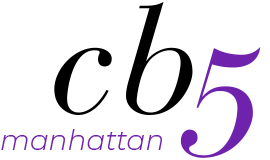
<< Back
Budget, Education & City Services
Resolution In Support of the Creation of a DOE Public School Program for Dyslexic Students at the Bleecker School Site
At the regularly scheduled monthly Community Board Five meeting on Thursday, February 13, 2020, the following resolution passed with a vote of 35 in favor; 0 opposed; 1 abstaining:
WHEREAS, Although the New York City Department of Education (DOE) does not specifically track the number of students labeled with dyslexia, it is known to affect as much as 5-20% of the population, regardless of primary language or background, and is a condition present in 80-90% of all those with learning disabilities; and
WHEREAS, Left unmitigated, dyslexia increases the risk of anxiety, depression, low self-esteem, peer rejection, and absenteeism. As a result, children with unlabeled dyslexia are more likely to drop out of school and, as adults, have higher rates of unemployment, anxiety and depression and are more likely to interact with the criminal justice system; and
WHEREAS, The achievement gap between typical and dyslexic readers impacts students as early as kindergarten and persists and often worsens over time, making addressing the needs of dyslexic students a critical education and equity issue for the city; and
WHEREAS, The DOE currently has few and inconsistent systems to address the needs of students with dyslexia; and
WHEREAS, Families of students with dyslexia face a steep and costly path, often through a labyrinth of government bureaucracy, to obtain critical services. Only those families with significant time and/or financial resources are able to navigate the complex system to fund, for example:
1. Private neuropsychological evaluations to identify dyslexia;
2. Private tutoring;
3. Tuition for private special education, potentially in excess of $60,000 annually; and, 4. Annual retainers for special education lawyers to sue the DOE to recover the cost of tuition; and,
WHEREAS, The DOE conducts a psychoeducational evaluation, not a neuropsychological evaluation, and a neuropsychological examination is most helpful in clarifying whether an identified reading disorder is due to dyslexia; and dyslexia was not until recently a classification in the DOE’s Individualized Education Program (IEP) process, instead falling under the overinclusive term “Learning Disability;” and
WHEREAS, Currently the DOE and School Construction Authority (SCA) does not fund or build new schools or classroom space based on learning type; and
WHEREAS, The DOE currently operates no public schools solely devoted entirely to teaching children with dyslexia; and
WHEREAS, Due to the lack of publicly provided in-school resources, many dyslexic students are forced to leave public schools and instead seek special education services provided by private schools, which the City will sometimes subsidize; and
WHEREAS, City spending on private school tuition for learning disabled children was upwards of $244 million in 2017-2018; and
WHEREAS, While dyslexia is never cured, there are private and charter schools that follow a curricula including the Orton-Gillingham (OG) approach to reading that have allowed some children with dyslexia to return to mainstream educational tracks, particularly when those students’ dyslexia was identified early and the curricula implemented before the end of the third grade; and
WHEREAS, New York City has the option to build a 100,000 square foot public school on the Bleecker School site in Greenwich Village on land owned by New York University; and
WHEREAS, If New York City fails to exercise the option of creating a school, the opportunity to utilize this site will pass back to NYU; and
WHEREAS, The proposed creation of a public school program for dyslexic students is to ensure access to the program by those who need it most, including those who are least able to navigate the current system; and
WHEREAS, The ultimate city-wide goal is to encourage dyslexia screening of all students; and
WHEREAS, The intention is to work with experts to define a simpler, more accessible, and more tailored screening methodology; and
WHEREAS, The admissions criteria and screening process for the proposed Bleeker Street school site is still to be determined; and
WHEREAS, The curriculum has also not yet been determined, but the intent is to follow approaches and
methods such as OG that have been successful in allowing some children to return to the general
education population by high school; and
WHEREAS, While CB5 recognizes that there is a chance that creating a school solely for dyslexic
children could lead to additional stigmatization, CB5 feels such a school would more effectively serve the
needs of such children than the currently available alternatives; and
WHEREAS, The intention for this school is to create a model that can be replicated; and
WHEREAS, The DOE has failed to develop comprehensive early screening, curriculum, teacher training,
programs and schools to support and teach children with dyslexia, creating a deeply inequitable system
that is out of reach for the vast majority of New York City families; therefore, be it
RESOLVED, Community Board Five supports the development of the Bleecker School Site; and be it
further
RESOLVED, Community Board Five supports the creation of a DOE public school for dyslexic
students at the Bleecker Street school site.
